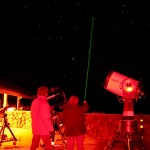Those of us who use green lasers for astronomy outreach are always worried about law enforcement cracking down on these devices. As the lasers get cheaper and more available they inevitably get into the hands of those who do not use them responsibly. Worse, the lasers are easily available at power levels that are truly dangerous.

Illuminating an aircraft with a laser can be prosecuted under federal law. Not because there is any specific statute addressing lasers, but as it is deemed “Interference with a Crewmember” using an interpretation of a pre-existing 1961 federal law, specifically 14 CFR 91.11.
The FAA has put together a new webpage on lasers and aircraft safety. The page organizes and links some informative resources. This includes a couple reports on the possible effects of laser illumination on aircraft crew, as well as the legal and regulatory recommendations of the FAA. I urge anyone who uses these devices to follow the link and do a little reading.
Used responsibly these lasers are extraordinarily useful in astronomy education. Nothing grabs the crowd’s attention so quickly as that brilliant green beam. Everyone can follow along without confusion as objects are pointed to across the sky. From the constellations to the Milky Way, satellites, planets and zodiacal light, on to star clusters and galaxies, everyone knows right where to look. I do prefer lasers in the 20-30mW range, bright enough to be seen by a crowd, even under moonlight. Not powerful enough to easily injure in the case of a brief exposure to the beam.

